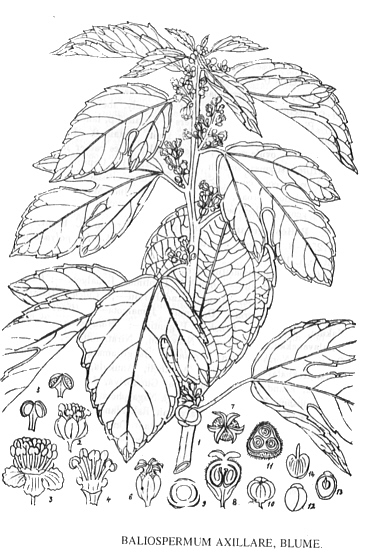

Zitierweise / cite as:
Carakasaṃhitā: Ausgewählte Texte aus der Carakasaṃhitā / übersetzt und erläutert von Alois Payer <1944 - >. -- Anhang A: Pflanzenbeschreibungen. -- Baliospermum montanum Muell.-Arg. -- Fassung vom 2007-05-10. -- URL: http://www.payer.de/ayurveda/pflanzen/baliospermum_montanum.htm
Erstmals publiziert: 2007-03-19
Überarbeitungen: 2007-05-10 [Ergänzungen]
Anlass: Lehrveranstaltung SS 2007
©opyright: Dieser Text steht der Allgemeinheit zur Verfügung. Eine Verwertung in Publikationen, die über übliche Zitate hinausgeht, bedarf der ausdrücklichen Genehmigung des Verfassers
Dieser Text ist Teil der Abteilung Sanskrit von Tüpfli's Global Village Library
WARNUNG: dies ist der Versuch einer
Übersetzung und Interpretation eines altindischen Textes. Es ist keine
medizinische Anleitung. Vor dem Gebrauch aller hier genannten Heilmittel wird
darum ausdrücklich gewarnt. Nur ein erfahrener, gut ausgebildeter ayurvedischer
Arzt kann Verschreibungen und Behandlungen machen!
Falls Sie die diakritischen Zeichen nicht dargestellt bekommen, installieren Sie eine Schrift mit Diakritika wie z.B. Tahoma.
Verwendete und zitierte Werke siehe: http://www.payer.de/ayurveda/caraka0001.htm

Abb.: Baliospermum montanum Muell.-Arg.
[Bildquelle: Kirtikar-Basu, ©1918]
Drury:
"Baliospermum montanum (Muller). N. O. Euphorbiaceae" Description.—Undershrub ; upper leaves lanceolate, acute at base, lower ones broader, ovate, and often cordate at the base, sinuately toothed or deeply 3-lobed, marked with long scattered hairs; inflorescence commonly bisexual, males more loose than the females, and longer peduncled, all shorter than the petioles; fruit-bearing pedicels deflexed; sterile bracteoles numerous; segments of the male calyx orbicular-ovate, of the female lanceolate; capsules sub-globose, tridymous, puberulous; seeds smooth, at length marbled. Dec. Prod. xv. s. 2, p. 1125.—Jatropha montana, Willd.— Croton polyandrum, Roxb.—B. polyandrum, Wight Icon. t. 1885.——Hills in Bengal. Northern parts of the Peninsula. Malabar.
Medical Uses.—The seeds are cathartic, and probably furnish the greater part of the Jumalgota of the drug-sellers. East of the Sutlej its leaves are in high repute for wounds, and its sap is believed to corrode iron.—Stewart's Punj. Plants."
[Quelle: Drury, Heber <1819 - 1872>: The useful plants of India : with notices of their chief value in commerce, medicine, and the arts. -- 2d ed. with additions and corrections. London : Allen, 1873. -- xvi, 512 p. ; 22 cm. -- s.v.]
Dutt:
"BALIOSPERMUM MONTANUM, Mull. Sans. Dantī. Vern. Dantī, Hind. Beng.
The seeds of Baliospermum montanum are described as drastic. Like croton seeds they are boiled in milk before use. The root of the plant is considered cathartic. Both are much used in diseases where purgatives are indicated. The following are a few examples of prescriptions containing these medicines.
Nārācha rasa. Take of mercury, borax and black pepper, one part each, sulphur, ginger and long pepper two parts each, seeds of Baliospermum montanum nine parts; powder the ingredients and make into two-grain pills with water. These are given in constipation and tympanites.
Danti haritaki. Take twenty-five large chebulic myrobalans and enclose them in a piece of cloth; then take of the roots of Baliospermum montanum and Ipomoea Turpethum (trivrit), each two hundred tolās, water sixty-four seers, boil them together till the water is reduced to eight seers. Strain the decoction, take out the chebulic myrobalans and fry them in thirty two tolās of sesamum oil. To the strained decoction add two hundred tolās of old treacle ; then boil till reduced to the proper consistence for a confection. Now add to the mass the following substances, namely powdered root of Ipomoea Turpethum (trivrit) thirty-two tolās, long pepper and ginger, each eight tol|s, and stir them well ; when cool add thirty-two tolās of honey, cinnamon, cardamom, leaves called tejapatra, and the flowers of Mesua ferrea ( nāgakesara ) each eight tolās, and prepare a confection. The chebulic myrobalans should be kept imbedded in the medicine. Two tolās of the confection and one of the chebulic myrobalans are to be taken every morning.
Guḍāṣṭaka. Take of danti, trivrit and plumbago roots, black pepper, long pepper, ginger and long pepper root, equal parts in fine powder ; treacle, equal in weight to all the other ingredients and mix. Dose, about a tolā every morning in flatulence and retained secretions, anasarca, jaundice, etc."
[Quelle: Dutt, Uday Chand: The materia medica of the Hindus / Uday Chand Dutt. With a glossary of Indian plants by George King. -- 2. ed. with additions and alterations / by Binod Lall Sen & Ashutosh Sen. -- Calcutta, 1900. - XVIII, 356 S. -- S. 229 - 231.]